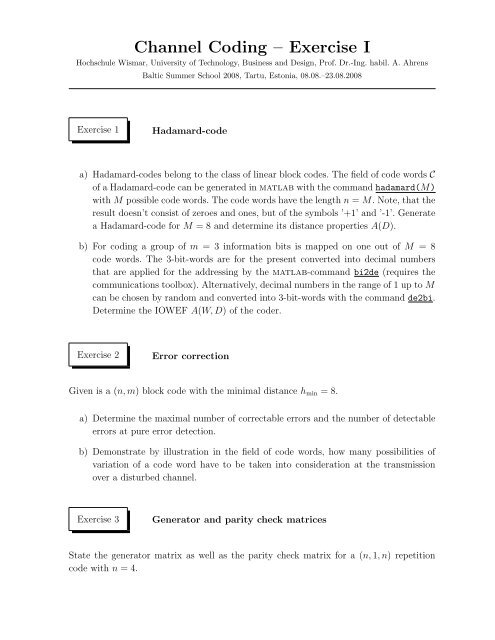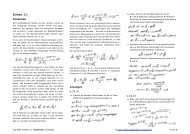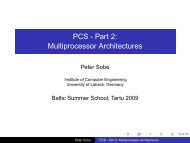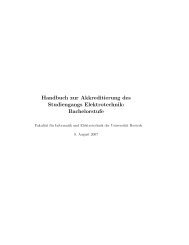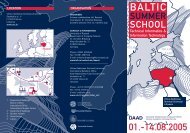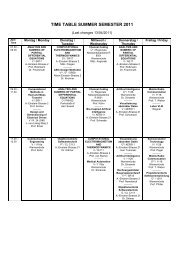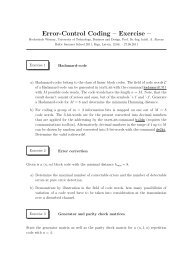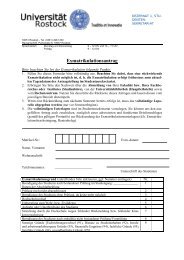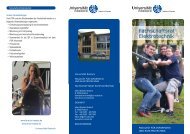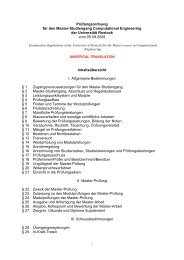Channel Coding â Exercise I
Channel Coding â Exercise I
Channel Coding â Exercise I
Create successful ePaper yourself
Turn your PDF publications into a flip-book with our unique Google optimized e-Paper software.
<strong>Channel</strong> <strong>Coding</strong> – <strong>Exercise</strong> I<br />
Hochschule Wismar, University of Technology, Business and Design, Prof. Dr.-Ing. habil. A. Ahrens<br />
Baltic Summer School 2008, Tartu, Estonia, 08.08.–23.08.2008<br />
<strong>Exercise</strong> 1<br />
Hadamard-code<br />
a) Hadamard-codes belong to the class of linear block codes. The field of code words C<br />
of a Hadamard-code can be generated in matlab with the command hadamard(M)<br />
with M possible code words. The code words have the length n = M. Note, that the<br />
result doesn’t consist of zeroes and ones, but of the symbols ’+1’ and ’-1’. Generate<br />
a Hadamard-code for M = 8 and determine its distance properties A(D).<br />
b) For coding a group of m = 3 information bits is mapped on one out of M = 8<br />
code words. The 3-bit-words are for the present converted into decimal numbers<br />
that are applied for the addressing by the matlab-command bi2de (requires the<br />
communications toolbox). Alternatively, decimal numbers in the range of 1 up to M<br />
can be chosen by random and converted into 3-bit-words with the command de2bi.<br />
Determine the IOWEF A(W, D) of the coder.<br />
<strong>Exercise</strong> 2<br />
Error correction<br />
Given is a (n, m) block code with the minimal distance h min = 8.<br />
a) Determine the maximal number of correctable errors and the number of detectable<br />
errors at pure error detection.<br />
b) Demonstrate by illustration in the field of code words, how many possibilities of<br />
variation of a code word have to be taken into consideration at the transmission<br />
over a disturbed channel.<br />
<strong>Exercise</strong> 3<br />
Generator and parity check matrices<br />
State the generator matrix as well as the parity check matrix for a (n, 1, n) repetition<br />
code with n = 4.
<strong>Exercise</strong> 4<br />
Modification of linear block codes<br />
A (5, 4) linear block code is constructed by adapting a (7, 4) block code. The (7, 4) code<br />
can be described by the following generator matrix<br />
⎛<br />
⎞<br />
0 1 0 1 1 0 0<br />
G = ⎜ 1 0 1 0 1 0 0<br />
⎟<br />
⎝ 0 1 1 0 0 1 0 ⎠ .<br />
1 1 0 0 0 0 1<br />
a) Construct the codewords of the (5, 4) code and list them!<br />
b) What is the minimum distance of the (5, 4) code!<br />
<strong>Exercise</strong> 5<br />
Syndrome decoding<br />
a) State the number of syndromes of the (7, 4, 3)-Hamming code and compare it with<br />
the number of correctable error patterns.<br />
b) The word d = (1 1 0 1 0 0 1) is found at the receiver. Which information word i was<br />
sent with the greatest probability?<br />
<strong>Exercise</strong> 6<br />
<strong>Coding</strong> program<br />
Write a matlab-programm which codes and again decodes a certain number of input<br />
data bits. Besides it shall be possible to insert errors before the decoding. The (5, 2, 3)-<br />
Hamming code shall be used.<br />
Hint: The (5, 2, 3)-Hamming code maps m = 2 information symbols onto n = 5 code<br />
symbols. Within the matlab-program, m information symbols are randomly chosen using<br />
randint and encoded by the generator matrix. A randomly determined error vector is<br />
added and the syndrome is calculated. Please notice: all calculations have to be executed<br />
within GF (2).
<strong>Channel</strong> <strong>Coding</strong> – <strong>Exercise</strong> II<br />
Hochschule Wismar, University of Technology, Business and Design, Prof. Dr.-Ing. habil. A. Ahrens<br />
Baltic Summer School 2008, Tartu, Estonia, 08.08.–23.08.2008<br />
<strong>Exercise</strong> 7<br />
Convolution code<br />
Given is a convolution code with the code rate R = 1/3, memory (K − 1) = 2 and the<br />
generator polynomials g 1 (x) = 1 + x + x 2 and g 2 (x) = 1 + x 2 and g 3 (x) = 1 + x + x 2 .<br />
a) Determine the output sequence for the input sequence i = (0 1 1 0 1 0).<br />
b) Sketch the corresponding Trellis chart in the case of the under a) given input sequence.<br />
c) Sketch the state diagram of the encoder.<br />
d) Determine the corresponding free distance h free .<br />
<strong>Exercise</strong> 8<br />
Catastrophic codes<br />
Given is the convolution code with the generator polynomial g(x) = (1 + x 2 , 1 + x). Show<br />
that this is a catastrophic code and explain the consequences.<br />
<strong>Exercise</strong> 9 Puncturing of convolution codes of the rate 1/n<br />
Given is the non-recursive convolution code with the generators g 1 (x) = 1 + x + x 3 and<br />
g 2 (x) = 1 + x + x 2 + x 3 . The non-recursive convolution code shall now be punctured to<br />
the code rate R = 2/3. Give several puncturing patterns and find out, if the puncturing<br />
results in a catastrophic code.
<strong>Exercise</strong> 10<br />
Viterbi-decoding<br />
Given is a convolution code with g 1 (x) = 1+x+x 2 and g 2 (x) = 1+x 2 , where a terminated<br />
code shall be used.<br />
a) Generate the corresponding Trellis and encode the information sequence i = (1101).<br />
b) Conduct the Viterbi-decoding respectively for the transmitted code sequence c =<br />
(110101001011) and for the two disturbed receiving sequences d 1 = (111101011011)<br />
and d 2 = (11 11 10 01 10 11) and describe the differences.<br />
c) Check the results with the help of a Matlab-program. Define the convolution code<br />
with G=[7;5], r flag=0 and term=1, generate the trellis diagram with trellis =<br />
make trellis(G,r flag) and sketch it with show trellis(trellis). Encode the<br />
information sequence i with c = conv encoder (i,G,r flag,term) and decode<br />
this sequence with<br />
viterbi omnip(c,trellis,r flag,term,length(c)/n,1).<br />
Decode now the sequences d 1 and d 2 .<br />
d) Now the influence of the error structure at the decoder input shall be examined.<br />
Therefor specifically add four errors, that you once arrange bundled and another<br />
time distributed in a block, to the encoded information sequence. How does the<br />
decoding behave in both cases?<br />
<strong>Exercise</strong> 11<br />
Viterbi-decoding with puncturing<br />
Given is a convolution code with g 1 (x) = 1 + x + x 2 and g 2 (x) = 1 + x 2 , out of which shall<br />
be generated a punctured code by puncturing with the scheme<br />
P 1 =<br />
( 1 1 1 0<br />
1 0 0 1<br />
)<br />
.<br />
a) Determine the code rate of the punctured code.<br />
b) Conduct the Viterbi-decoding in the case of the undisturbed receiving sequence<br />
d = (1 1 0 0 0 1 0 1) (pay attention to the puncturing!).


